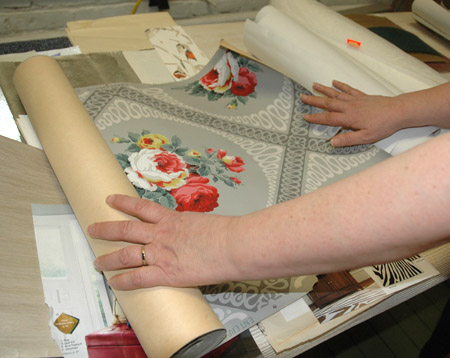
There are 6 weeks left until the Lowell Folk Festival. Between now and then, we are posting examples of folk crafts that will be demonstrated in Lucy Larcom Park. Our theme is paper traditions, and that includes the occupational craft of paper hanging.
Heidi L. Johnson is pretty sure her passion for paperhanging started in her grandmother’s guestroom where the walls were papered with a faux bois of white and beige with lavender roses. As a five year old, she’d stare at the walls. “I was figuring out pattern repeat. I knew a machine had printed that and I could tell that it had to be engineered around the room.”
The tools of the paperhangers’ trade may be simple (straight edge razor blades, levels, electronic lasers, bristle sweeps, and pasting machines), but their use requires great skill. In fact, wallpaper hanging is considered a higher trade in the building trades. It demands planning, engineering skills, visualizing patterns, knowing materials, prepping walls, and applying the product swiftly and accurately. “It looks easier than it is,” Heidi says, adding that wallpaper hanging is like upholstering a room. “The sign of a good craftsman is to hide the skill.”
 Heidi’s background in textile design and her experience in designing and manufacturing wallpaper, make her especially well-suited to papering interiors. She has been a member of the National Guild of Professional Paperhangers since 1994, an occupational group she describes as “the paper geeks of the industry.”
Heidi’s background in textile design and her experience in designing and manufacturing wallpaper, make her especially well-suited to papering interiors. She has been a member of the National Guild of Professional Paperhangers since 1994, an occupational group she describes as “the paper geeks of the industry.”
Heidi will be demonstrating her craft at the 2014 Lowell Folk Festival in the Folk Craft area along Lucy Larcom Park.


